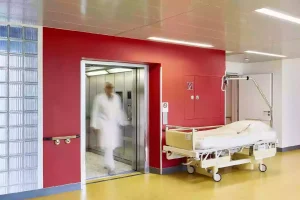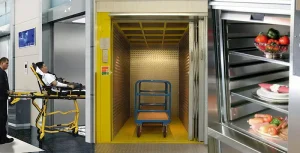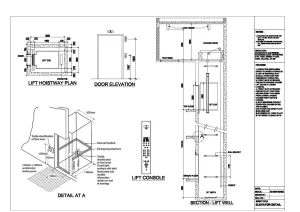When purchasing a service elevator, it is important not only to clarify usage requirements but also to evaluate whether the investment is reasonable from a budgetary perspective. Understanding the market price range and the key factors that affect service elevator costs can help companies reduce unnecessary expenses and allocate project funds effectively. In 2025, the upgrade of elevator technology and the continued fluctuation of raw material prices make determining the value of a service elevator essential preliminary work.
Understanding Service Elevators in 2025
The Evolution of Service Elevator Technology
Modern service elevators integrate IoT diagnostics, energy-efficient drive systems, and advanced safety mechanisms. These upgrades improve equipment reliability and reduce long-term operating costs, though they may also increase the initial purchase price.
Types of Service Elevators on the Market
There are many types of service elevators available. We categorize them by use environment and transport application:
-
Freight elevators: Featuring strong structures and large load capacity, they are suitable for factories, warehouses, logistics centers, and other places where heavy items are frequently transported. Some models support over 3 tons of load, ideal for high-frequency vertical movement.
-
Dumbwaiter elevators: Compact and easy to install, commonly used in hotel kitchens, restaurants, and canteens to quickly transport food, dishes, and light equipment between floors.
-
Medical service elevators (hospital elevators): Featuring wide cabins and smooth operation, these are ideal for hospitals, rehabilitation centers, and clinics. They transport beds, medical devices, and emergency equipment, and usually meet accessibility and sanitation requirements.
Average Price Range of Service Elevators in 2025
Service elevator prices vary depending on specifications and use cases. Below are current mainstream configurations and price ranges for three types of service elevators:
Small Service Elevator
-
Standard configuration:
Basic shaft structure with a simple control system, often used in small commercial buildings of 1 to 3 floors. -
Price range:
Approximately $4,000–$8,000 -
Advantages:
-
Low cost, ideal for budget-constrained small projects
-
Quick installation with minimal structural changes
-
Common in restaurants, hotel kitchens, and small lodging venues
-
-
Disadvantages:
-
Low load capacity (usually no more than 200 kg)
-
No support for advanced scheduling or remote monitoring
-
Medium-sized Service Elevator
-
Standard configuration:
Supports over three floors, includes sensors, status displays, and basic scheduling, suitable for small to mid-sized commercial or medical use. -
Price range:
Approximately $15,000–$30,000 -
Advantages:
-
Balanced performance for multiple use cases
-
Typical load between 500–2000 kg
-
Applicable in malls, office buildings, restaurant chains, and medical facilities
-
-
Disadvantages:
-
May require additional construction if no shaft exists in the original structure
-
Configuration upgrades raise the price ceiling
-
Large or Customized Service Elevators
-
Standard configuration:
High-capacity (up to 5000 kg+), automatic doors, non-slip floors, networked monitoring systems. Size and control logic can be tailored. -
Price range:
$35,000–$80,000+ depending on customization level -
Advantages:
-
High load capacity and reliability
-
Capable of transporting bulky items such as medical carts and industrial racks
-
Can be integrated with smart building or logistics systems
-
-
Disadvantages:
-
High upfront investment and extended installation period
-
Requires more building space and structural support
-
Factors Affecting the Price of Service Elevators
Service elevator pricing is influenced by several factors. Understanding them helps build accurate budgets and avoid unexpected project costs.
Elevator Type and Use Case
Different types have different manufacturing requirements. Medical elevators require:
-
-
Accessibility features
-
Antibacterial materials
-
Emergency stop systems
Industrial applications may require: -
Explosion-proof designs
-
Dust protection
These features significantly increase cost.
-
Load Capacity and Car Size
Load rating and cabin dimensions determine the necessary motor power, guide rails, and cable specifications. Larger capacities require more complex systems and structures, driving up the cost.
-
Installation Environment and Complexity
Installation site conditions also impact cost. For renovations or structurally complex buildings, additional costs (e.g., reinforcement, rewiring) may add up to 20% of the elevator body price. -
Brand and Service System
A brand’s value reflects not only hardware quality but also support, maintenance, and customizability. Top-tier international brands may cost more but offer faster delivery, stronger support, and long-term warranty. Smaller brands suit limited-budget or less demanding projects.
Price Trends for Service Elevators in 2025
Due to global supply chain disruptions and advances in elevator tech, prices in 2025 are trending upward:
Rising Material Costs
Steel, copper wire, electronics, and motors have seen a 10–15% increase since 2023, directly raising the cost of elevator structures and components.
Smart Features Becoming Standard
Mid-to-high-end models now often include:
- Intelligent controls
- Cloud monitoring
- Energy recovery systems
While they raise initial costs, these features improve energy efficiency and enable real-time diagnostics—especially valuable in offices and healthcare facilities.
How to Control the Procurement Cost of Service Elevators
Despite rising prices, you can manage your budget effectively with these strategies:
-
Choose the Right Model for Your Load and Usage
Avoid over-specification. Base your selection on load weight, usage frequency, and number of floors. Don’t use heavy-duty systems where light-duty would suffice. -
Plan Regular Maintenance to Minimize Downtime
A failure can delay operations and raise labor costs. Schedule routine inspections (monthly or quarterly) from the outset to extend lifespan and prevent costly repairs. -
Explore Subsidies and Policy Incentives
Some regions offer subsidies or tax benefits for energy-efficient or accessible elevator systems. In certain countries, projects may receive 5–20% subsidies when meeting green standards. Consult local authorities early in the planning stage.
Conclusion
The price of a service elevator depends on size, load, features, and installation environment. In 2025, choosing the wrong type can lead to budget waste or performance issues. Matching the right specs to your needs helps control investment and boost efficiency.
Want a quote tailored to your project? Contact BDFUJI for an accurate price plan.
FAQ
Q: What is the average price of a service elevator in 2025?
A: Most standard service elevators cost between $15,000 and $30,000, depending on capacity and features.
Q: How often do service elevators require maintenance?
A: Preventive inspections are recommended every 1 to 3 months, depending on usage intensity.











